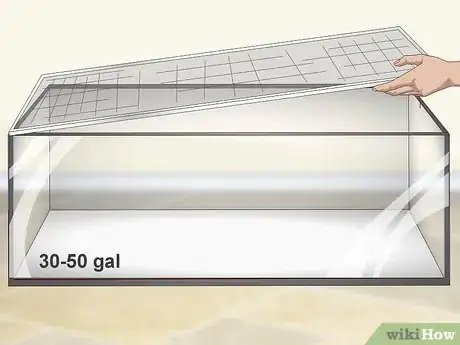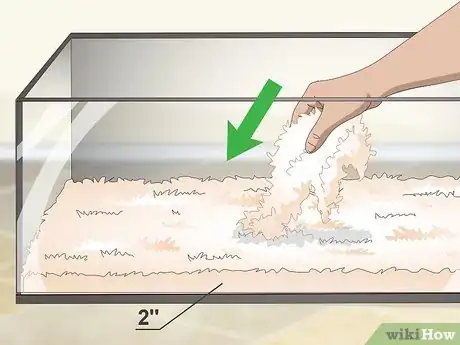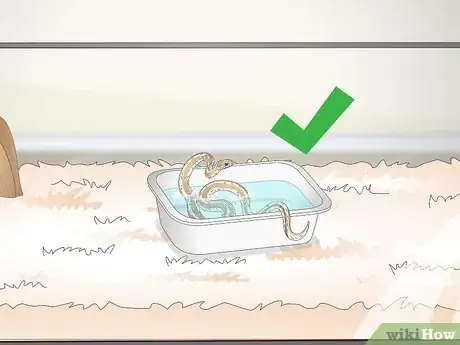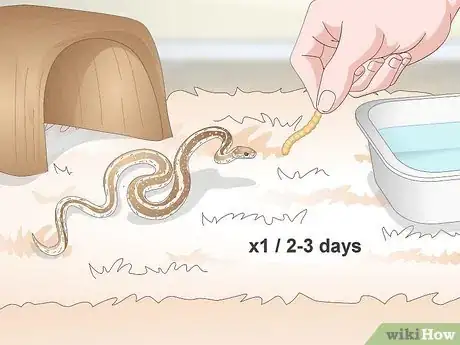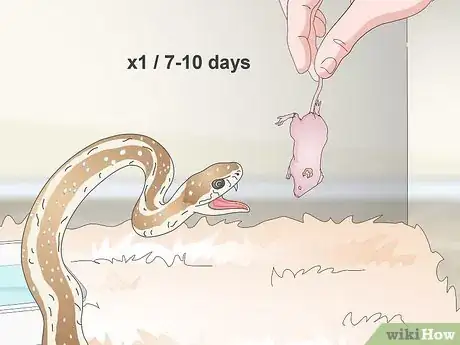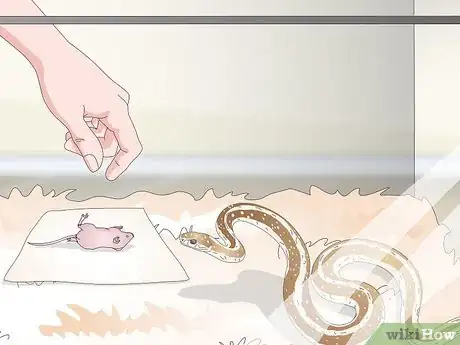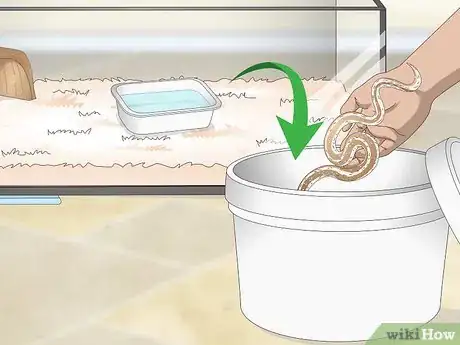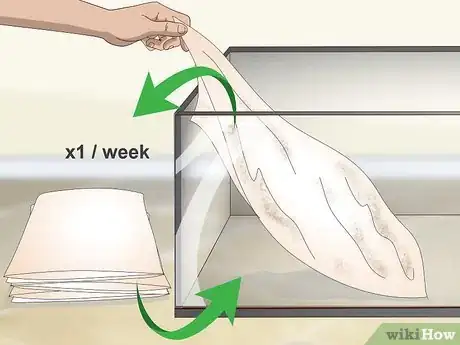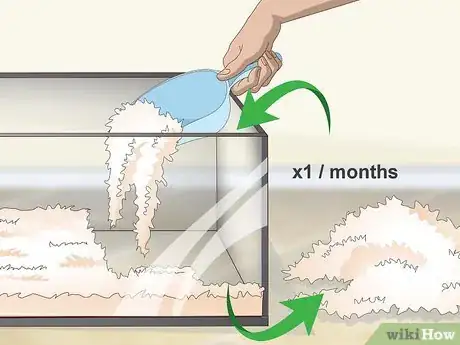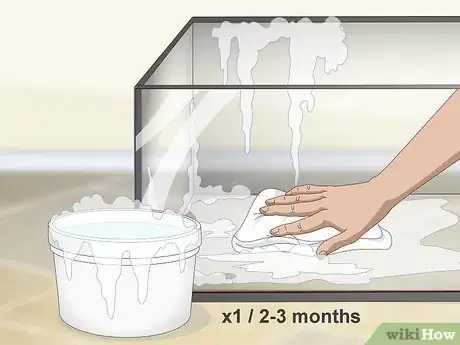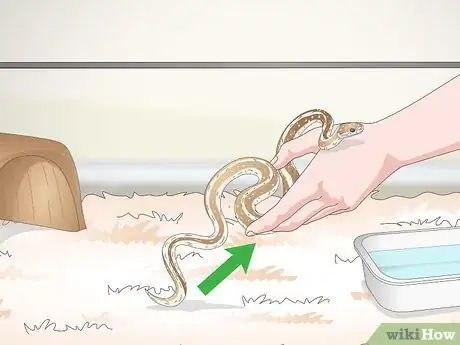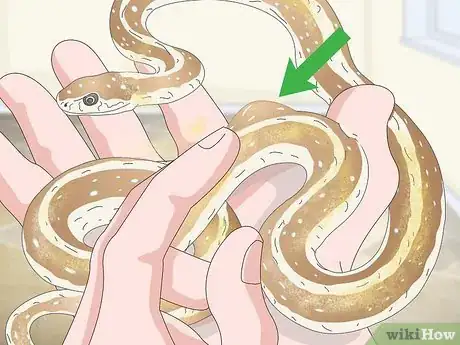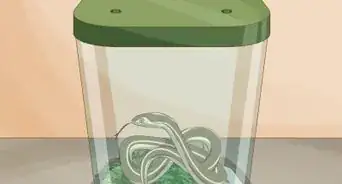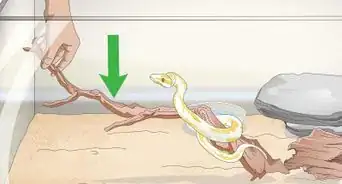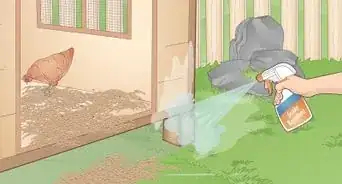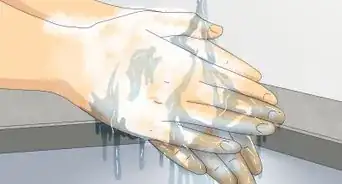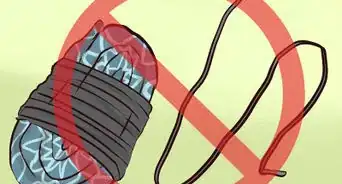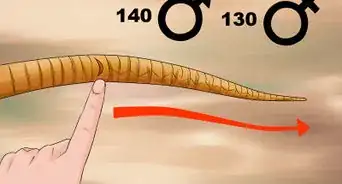This article was co-authored by Jeff Jensen. Jeff Jensen is a Reptile Specialist and the Owner of The Reptile Zone out of Bend, Oregon. With decades of experience with reptiles and wildlife, Jeff specializes in providing advice and guidance on proper reptile care. As a former science teacher and employee of the San Antonio Zoo and an accomplished herpetologist, Jeff’s dedication to knowledge and ethical pet trade practices led to The Reptile Zone being awarded a “Mark of Excellence” Award by Intrepid Marketing in 2018.
There are 12 references cited in this article, which can be found at the bottom of the page.
wikiHow marks an article as reader-approved once it receives enough positive feedback. This article received 15 testimonials and 86% of readers who voted found it helpful, earning it our reader-approved status.
This article has been viewed 200,367 times.
Garter snakes make great pets and it’s important to know how to care for them properly. Set up the enclosure first using a plastic tub or aquarium and add in a substrate, cage furniture, and a heating pad. Make sure that the snake always has access to fresh food and water, and that the enclosure is cleaned out regularly. Keep your snake happy and healthy through handling and regular health checks, and enjoy getting to know your new friend!
Steps
Setting up an Enclosure
-
1Choose a 30–50 US gal (110–190 L) plastic tub or aquarium with a lid. It is suitable to house smaller and younger garter snakes in smaller enclosures, while larger garter snakes require larger housing. Garter snakes are very active, so the enclosure needs to be big enough for them to move about.[1]
- Ensure that the plastic tub or aquarium has a lid that is tight fitting. This is because garter snakes are known for being escape artists. A screen lid that snaps onto the enclosure is best. If the lid has any areas of mesh or grille, check that the snake won’t be able to climb through past its eyes, as this means that it will be able to fit all the way through the gap.[2]
- An enclosure for 2 garter snakes should be approximately 55 US gal (210 L).[3]
-
2Fill the enclosure with a minimum of 2 in (5.1 cm) of substrate. The material that covers the floor of the enclosure is called the substrate. This needs to be kept dry and wet substrate needs to be removed in order to keep the garter snake healthy.[4] Ideal substrate choices for garter snakes are newspaper, paper towels, aspen shavings, alfalfa meal, and reptile bark.[5]
- Substrates that are unsafe for garter snakes include cedar, pine, or juniper tree bark chips, sand, clay cat litter, gravel, and dirt.
- Only use newspapers and/or paper towels for baby garter snakes.
- Garter snakes like to burrow into the substrate, so you can always add a little more.
Advertisement -
3Add cage furniture to help the garter snake to feel more secure. Snakes require at least 1 dark space to hide in within their enclosure. You can use plastic bowls, cardboard boxes, toilet paper tubes, or specialty snake hide boxes that can be purchased from pet stores or online. Cage furniture such as fake or real plants, wood, rocks, and decorations can also be good additions to the enclosure as the snake will enjoy exploring the objects.[6]
- Aim to have the opening to the hide box just slightly bigger than the width of the snake. It needs to be large enough for the snake to fit in, yet small enough so that the snake can feel enclosed and safe.
-
4Use a heating pad and a light bulb to maintain the temperature. Garter snakes are cold-blooded animals which means that they need their enclosure to be 75–85 °F (24–29 °C) in order to survive. Place a heating pad below 1 side of the enclosure and install a reflector or incandescent bulb above it. Use a thermometer to monitor that the warm part of the enclosure doesn’t rise above 86 °F (30 °C) and that the cool part doesn’t drop below 72 °F (22 °C). This creates a temperature gradient which means that the temperature changes depending on the location inside the enclosure.[7]
- The heating pad can be one specifically for reptiles or it can be a regular electric blanket that is set to the lowest temperature.
- It’s important to create a temperature gradient inside the enclosure. This allows the garter snake to move to a warmer area such as the heating pad if needed. It also lets the snake cool down in the cooler part of the enclosure. This is why the heating pad only warms part of the enclosure.
- A stick-on thermometer is an ideal way to get a good estimate of the temperature inside the enclosure.
- Temperatures that are above 91 °F (33 °C) can be dangerous for garter snakes. If the snake is moving quickly around the enclosure with its mouth open, this means that it is overheating. Immerse the snake in cool, running water and adjust the enclosure temperature to the appropriate range.
Providing Food and Water
-
1Choose a water dish that is big enough for the snake to curl up in. Garter snakes need a water dish to both drink water from and to soak in. Pick a bowl that is large and shallow. Make sure that the water dish in the enclosure is always filled with enough fresh water for the snake to soak. Change the water every day.[8]
- A common misconception about garter snakes is that they are aquatic creatures. While garter snakes do soak in the water from time to time, they need an enclosure that has plenty of dry areas to stay healthy. It is only the prey of wild garter snakes that are aquatic.
-
2Feed young garter snakes every 2-3 days. Give young garter snakes 2-3 earthworms, 2-3 feeder guppies, 1 large feeder platy, or 1/2-1/4 of a pinky mouse. Give the snake enough food so that it has a small, visible bulge.[9]
- It’s best to have young snakes on smaller, frequent meals as they can digest these more easily.
- A pinky mouse is a newborn mouse.
- Young garter snakes are generally 4.9–9.1 in (12–23 cm) in length.[10]
-
3Feed adult garter snakes every 7-10 days. What you feed the garter snake determines how often you need to feed it. If you are feeding your garter snake mice, give the snake 1 thawed, adult mouse per week. For garter snakes that eat nightcrawlers, chop the nightcrawler into quarters and feed the snake 1 nightcrawler twice per week.[11]
- Don’t use live mice as these can attack the snake.
- Adult garter snakes are 18.1–53.9 in (46–137 cm) in length.[12]
- Garter snakes can also eat frogs, toads, and fresh, whole fish. However, it isn’t recommended to feed garter snakes on a diet of solely fish due to potential parasites and deficiencies.
- Garter snakes do not eat crickets or mealworms.[13]
-
4Place the food on a paper towel or in a small dish inside the enclosure. Drop a thawed mouse onto a paper towel and the snake will usually investigate the food quickly. Use a small dish for worms and fish. Clean the feeding dish after each meal so that the enclosure doesn't smell.[14]
- Avoid placing food directly onto substrate such as wood bark chips. This is because the substrate may stick to the food, which will interfere with the snake's digestion.
- If the snake won’t eat the food, try moving the food around to see if the snake responds. Use tongs or tweezers to pick up a piece of food and wiggle it around to attract the attention of the snake. This should encourage the snake to eat the prey. Don’t use your hands to hold the food as the snake may accidentally bite you while it grabs the food.
Cleaning Your Snake's Enclosure
-
1Remove the snake before you clean the enclosure. Transfer the snake from the enclosure and into a small, plastic container with a lid. Make sure that the lid has small holes so that the snake can breathe, but that the holes aren’t large enough for the snake to escape.[15]
- If you cannot find a lid with holes, use an electric drill to create some.
-
2Change the substrate once per week if you're using paper towels. Remove the old substrate and discard it. Replace it with fresh, new paper towels. If the garter snake eats worms or fish, the substrate will need to be changed more frequently than if the snake is on a mouse diet.[16]
-
3Replace the substrate every few months if it's shavings, mulch, or bark. Remove feces and urea every week from the enclosure and add small amounts of new substrate to top it up if necessary. Completely remove the substrate every couple of months to replace it.[17]
- You can spot clean the substrate if it's messy before you need to fully replace it.[18]
-
4Clean the enclosure completely using soapy water every 2-3 months. Mix a few drops of dishwashing detergent into a bucket of warm water. Remove everything from the enclosure and use a cleaning rag to wipe down the enclosure walls and floor, the hides, the cage furniture, and the water bowl with the soapy water. Dry the enclosure fully using a clean rag before setting up the enclosure again and returning the snake.[19]
- If you are using a paper towel substrate, in addition to cleaning the whole enclosure every few months, simply wipe down the glass where the paper towels are soiled when you change them.
- If the cage furniture cannot be cleaned, such as objects made from cardboard, replace it when you clean the enclosure. Cage furniture that is made from plastic or wood can be wiped down and dried.
Keeping Your Snake Happy and Healthy
-
1Handle the snake by letting it climb through your hands. Always pick up the snake gently from the mid-body area, rather than the head or tail. Support its body as you hold it so that it feels safe and secure. Let it curl around your hands to explore.[20]
- Some garter snakes will be afraid of being handled at first. This means that it may thrash in your hands. In this scenario, keep a firm hold of it so that it doesn't fall. Other scared snakes may produce a foul-smelling liquid called musk. This isn't harmful and you can simply wash it off. Practice handling the snake regularly and helping it to feel safe and secure so that it feels more comfortable being handled.[21]
-
2Take the snake out of the enclosure at least once per week. If your snake is new, give it a few days to settle in first and make sure that it eats its first meal. Handle the snake regularly so that it can get used to you and learn to trust you. Over time, the snake will become more comfortable with being handled.[22]
- Regular handling also provides a good opportunity for checking the snake's health.
-
3Check the snake regularly to make sure it is healthy. Make sure that there aren't small lumps over its body or a hollow popping sound when it breathes, as this could indicate a problem with internal parasites. Check the snake's body for puffy, white sores which can indicate a blister disease that is caused by living in conditions that are too moist. Also, make sure that the snake sheds properly and doesn't retain old skin around its eyes and tail.[23]
- Take your snake to a veterinarian for treatment if it shows any of these symptoms.[24]
Community Q&A
-
QuestionCan two male garter snakes live together, or a male and a female?
 Community AnswerHaving a male and female in the same enclosure will stress out the female with the constant attempts of courtship. Two males should be fine, or two females.
Community AnswerHaving a male and female in the same enclosure will stress out the female with the constant attempts of courtship. Two males should be fine, or two females. -
QuestionWhat do they look like?
 Community AnswerGarter snakes have many different breeds and morphs, but most follow the pattern of two or three horizontal stripes on the back. Common Garter snakes have black bodies and yellow stripes. Do an online image search for the snake.
Community AnswerGarter snakes have many different breeds and morphs, but most follow the pattern of two or three horizontal stripes on the back. Common Garter snakes have black bodies and yellow stripes. Do an online image search for the snake. -
QuestionHow long does shedding take? When can I hold them again after they shed?
 Community AnswerShedding can take several hours to more than a day. Do not hold them for several hours after they have shed. They are weak and vulnerable at this stage.
Community AnswerShedding can take several hours to more than a day. Do not hold them for several hours after they have shed. They are weak and vulnerable at this stage.
Warnings
- Take the snake to visit a veterinarian if it stops eating or drinking normally, starts soaking excessively, or if it does not shed properly. The snake may require specialist, medical treatment.[25]⧼thumbs_response⧽
Things You’ll Need
- 30–50 US gal (110–190 L) plastic tub or aquarium with lid
- Substrate
- Hide boxes
- Cage furniture
- Heating pad
- Reflector or incandescent light bulb
- Thermometer
- Water dish
- Feeding dish
- Tongs or tweezers
- Dishwashing detergent
- Bucket
- Cleaning rags
References
- ↑ https://www.petmd.com/reptile/species/garter-snake#
- ↑ http://www.gartersnake.info/care/housing.php
- ↑ http://www.reptilesmagazine.com/Garter-Snake-Care-Sheet/
- ↑ Jeff Jensen. Reptile Specialist. Expert Interview. 8 April 2021.
- ↑ http://www.thamnophis.com/index.php?page=caresheet
- ↑ http://www.thamnophis.com/index.php?page=caresheet
- ↑ http://www.gartersnake.info/care/housing.php
- ↑ http://www.gartersnake.info/care/housing.php
- ↑ http://www.gartersnake.info/care/feeding.php
- ↑ http://www.biokids.umich.edu/critters/Thamnophis_sirtalis/
- ↑ http://www.gartersnake.info/care/feeding.php
- ↑ http://www.biokids.umich.edu/critters/Thamnophis_sirtalis/
- ↑ http://www.reptilesmagazine.com/Garter-Snake-Care-Sheet/
- ↑ http://www.gartersnake.info/care/feeding.php
- ↑ http://www.gartersnake.info/care/housing.php
- ↑ http://www.gartersnake.info/care/housing.php
- ↑ http://www.gartersnake.info/care/housing.php
- ↑ Jeff Jensen. Reptile Specialist. Expert Interview. 8 April 2021.
- ↑ http://www.uvma.org/snakes/garter-snakes.htm
- ↑ http://www.reptileknowledge.com/news/how-to-handle-a-pet-snake-handling-tips-for-beginners/
- ↑ http://www.gartersnake.info/care/handling.php
- ↑ http://www.uvma.org/snakes/corn-snakes.htm
- ↑ http://www.gartersnake.info/care/health.php
- ↑ Jeff Jensen. Reptile Specialist. Expert Interview. 8 April 2021.
- ↑ http://www.uvma.org/snakes/garter-snakes.htm
About This Article
To take care of a garter snake, keep it in a 30-50 gallon plastic tub or aquarium that’s fitted with a tight-fitting lid. Cover the bottom of the container with at least 2 inches of a substrate like shredded newspaper, alfalfa meal, or aspen shavings. Include a place for the snake to hide, like an upside-down box or a paper towel tube, which will help the snake feel more secure. Also, since snakes are cold-blooded and require warmth, make sure to set up a heating pad, light bulb, and thermometer to keep the cage between 75-85°F. Read on for tips on how to feed your garter snake!
